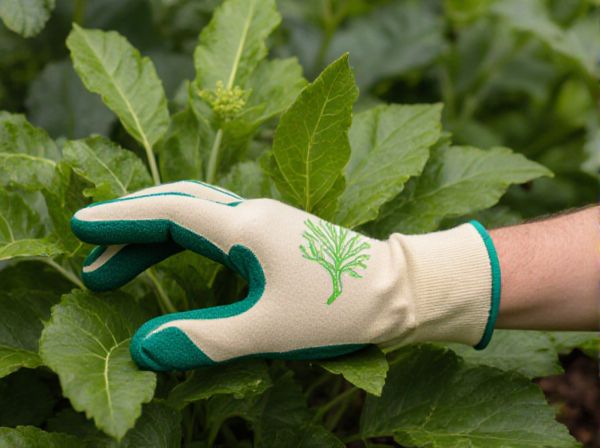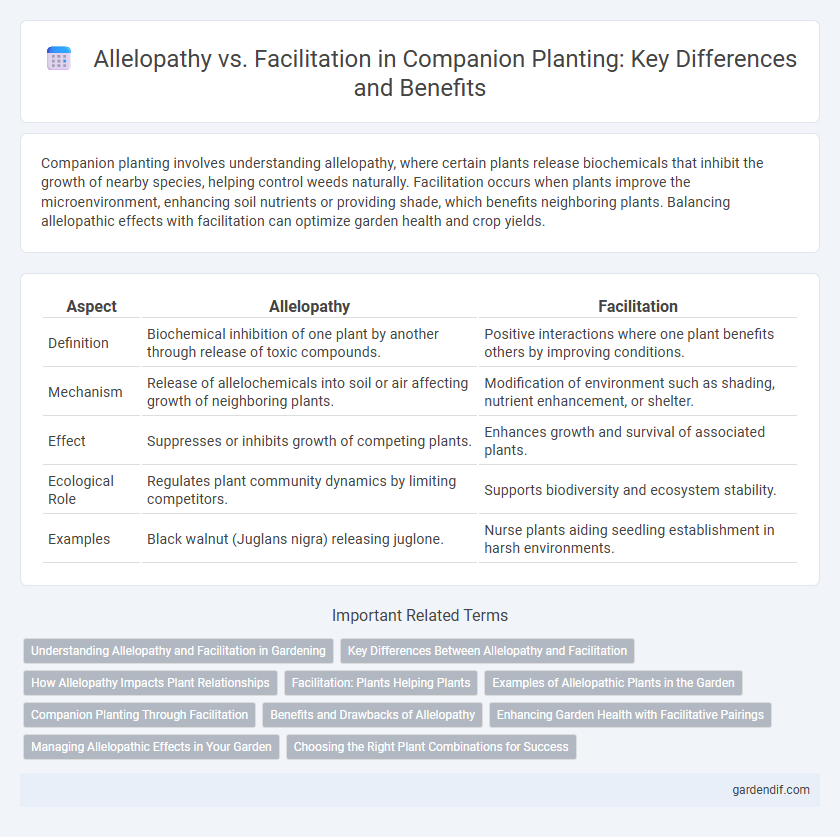
Allelopathy vs Facilitation Illustration
Companion planting involves understanding allelopathy, where certain plants release biochemicals that inhibit the growth of nearby species, helping control weeds naturally. Facilitation occurs when plants improve the microenvironment, enhancing soil nutrients or providing shade, which benefits neighboring plants. Balancing allelopathic effects with facilitation can optimize garden health and crop yields.
Table of Comparison
| Aspect | Allelopathy | Facilitation |
|---|---|---|
| Definition | Biochemical inhibition of one plant by another through release of toxic compounds. | Positive interactions where one plant benefits others by improving conditions. |
| Mechanism | Release of allelochemicals into soil or air affecting growth of neighboring plants. | Modification of environment such as shading, nutrient enhancement, or shelter. |
| Effect | Suppresses or inhibits growth of competing plants. | Enhances growth and survival of associated plants. |
| Ecological Role | Regulates plant community dynamics by limiting competitors. | Supports biodiversity and ecosystem stability. |
| Examples | Black walnut (Juglans nigra) releasing juglone. | Nurse plants aiding seedling establishment in harsh environments. |
Understanding Allelopathy and Facilitation in Gardening
Allelopathy in gardening involves plants releasing biochemicals that inhibit the growth of nearby species, impacting seed germination and nutrient uptake. Facilitation occurs when certain plants improve environmental conditions, such as enhancing soil nutrients or providing shade, benefiting neighboring plants. Understanding these interactions helps gardeners strategically select companion plants to optimize growth and pest resistance.
Key Differences Between Allelopathy and Facilitation
Allelopathy involves the chemical inhibition of one plant by another through the release of toxic substances, while facilitation refers to positive interactions where one plant enhances the growth or survival of another. Allelopathy often reduces biodiversity by suppressing competing species, whereas facilitation promotes community stability and resilience. These mechanisms differ fundamentally in their ecological roles, with allelopathy serving as a competitive strategy and facilitation acting as a cooperative process within ecosystems.
How Allelopathy Impacts Plant Relationships
Allelopathy significantly influences plant relationships by releasing biochemicals into the environment that inhibit the growth of competing species, thereby reducing biodiversity in the immediate area. These allelochemicals can suppress seed germination, root elongation, and nutrient absorption of neighboring plants, altering competitive dynamics. Understanding allelopathy is crucial for managing companion planting, as it determines which species can coexist beneficially or may hinder each other's growth.
Facilitation: Plants Helping Plants
Facilitation in plant ecology refers to the process where certain plants improve the growth and survival of neighboring species by modifying the environment, such as enhancing soil nutrients, providing shade, or attracting beneficial pollinators. Examples include nurse plants protecting seedlings from harsh conditions and legumes fixing nitrogen to enrich soil fertility for surrounding vegetation. This positive interaction plays a crucial role in ecosystem stability and biodiversity by supporting plant communities in stressful habitats.
Examples of Allelopathic Plants in the Garden
Black walnut (Juglans nigra) releases juglone, a compound toxic to many nearby plants, inhibiting their growth and demonstrating strong allelopathic effects in gardens. Eucalyptus species produce allelochemicals in leaf litter that suppress undergrowth, affecting plant diversity and garden composition. Sunflowers (Helianthus annuus) emit phytotoxins via roots and leaf leachates, reducing the germination and growth of surrounding weeds, showcasing an effective natural weed control method.
Companion Planting Through Facilitation
Companion planting through facilitation leverages beneficial plant interactions to enhance growth, pest resistance, and nutrient uptake without harmful competition. Plants like legumes fix nitrogen, enriching the soil and supporting neighboring crops such as corn and tomatoes, which thrive with improved nutrient availability. This facilitation method creates a symbiotic ecosystem that maximizes yield and sustainability in organic gardening systems.
Benefits and Drawbacks of Allelopathy
Allelopathy involves the chemical inhibition of one plant by another through the release of toxic substances, which can suppress weed growth and reduce pest infestations, enhancing crop health and productivity. However, allelopathic compounds may also negatively affect beneficial species and soil microorganisms, potentially disrupting biodiversity and soil fertility. Understanding allelopathic interactions is crucial in companion planting to balance crop protection and ecosystem health effectively.
Enhancing Garden Health with Facilitative Pairings
Facilitative pairings in companion planting improve garden health by promoting beneficial interactions between plants, such as nutrient sharing and pest deterrence, which boost overall growth and resilience. Unlike allelopathy, where plants release chemicals to inhibit neighbors, facilitation encourages positive relationships that enhance soil quality and biodiversity. Choosing compatible species like legumes with cereals maximizes nutrient availability and strengthens the garden ecosystem naturally.
Managing Allelopathic Effects in Your Garden
Allelopathy involves plants releasing biochemicals that inhibit the growth of neighboring species, potentially harming garden biodiversity. To manage allelopathic effects, implement companion planting strategies by pairing tolerant species with allelopathic plants such as black walnut or eucalyptus. Regular soil amendment with organic matter and mulching can also mitigate toxin buildup, promoting healthier plant interactions and sustainable garden growth.
Choosing the Right Plant Combinations for Success
Allelopathy involves certain plants releasing chemicals that inhibit the growth of neighboring species, necessitating careful selection to avoid negative interactions in companion planting. Facilitation occurs when plants positively influence each other's growth through mechanisms such as improved nutrient uptake or pest deterrence, enhancing overall garden productivity. Understanding the specific allelopathic traits and facilitative potentials of plants ensures optimal combinations that promote success in sustainable gardening.
Allelopathy vs Facilitation Infographic

 gardendif.com
gardendif.com